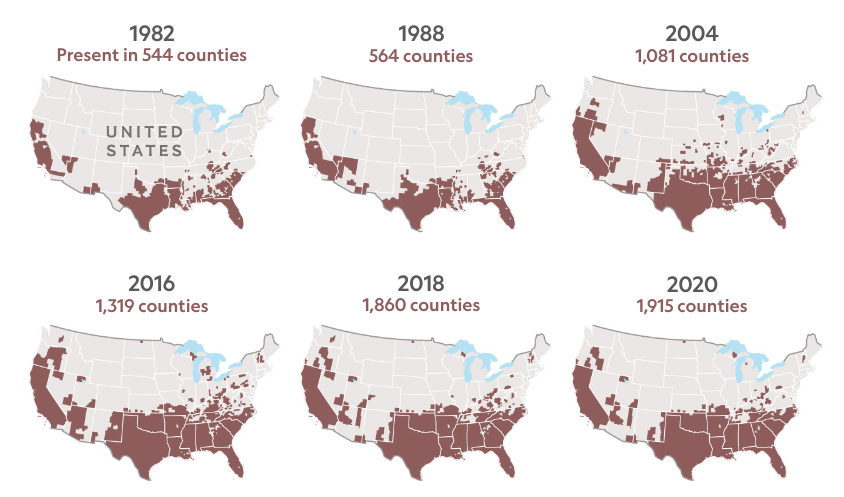The World is Ending: Feral Hog Invasion
Feral hog populations expand northward from 1982 – 2020. With feral swine populations in Virginia and Pennsylvania, Maryland is now openly accessible to further migration.
America is being taken over by feral hogs.
Feral hogs are an invasive, cunning and highly destructive species of swine that reproduce at an overwhelming rate. Female hogs can have their first litter at seven months old, and produce up to three litters a year. With around 12 piglets to a litter, and considering about fifty percent of those will be females who can reproduce themselves in just seven months, the feral hog population is growing at an exponential rate.
According to National Geographic, feral hogs were first introduced to America by colonists, who brought them over from Europe in the 16th century as a food source. Despite being hunted by humans ever since, their intelligence and adaptability has allowed feral hogs to learn how to evade the traps and hunting techniques used against them. Research by the United States Department of Agriculture (USDA) has found that “most nonlethal methods such as habitat manipulation, frightening devices, and guard animals, are ineffective at preventing feral hog problems.”
Currently, the most common way of dealing with the overwhelming feral hog population is by hunting/shooting them. Citizens are encouraged to hunt feral hogs, to the extent that states like Texas and Tennessee promote hog hunting bachelor parties. “I think there would be little action against the feral hogs [if they were to come to Montgomery County]. I believe most people don’t have any sort of firearm, at least in Rockville, so defending against them will be very tricky,” senior Megan Liu said.
Feral hogs are a large threat to agriculture, most notably because of a common destructive behavior called rooting: hogs dig their snouts into the ground and plow through the earth, destroying crops, private property and anything else in their way. National Geographic summarizes that feral hogs root to find food, cool off, communicate and simply for fun.
The USDA estimates that feral hogs cause more than $2.5 billion in agricultural damage every year, ranging from destroying property to eating crops meant for humans. “We haven’t been able to find a crop that feral swine won’t eat,” research economist Stephanie Shwiff told National Geographic.
Rural areas are not the only communities affected by the hog invasion. Feral hogs don’t discriminate between farms and suburban or urban communities and have been known to destroy private yards, public outdoor recreation areas such as golf courses, and even cemeteries. “My backyard is basically in the woods, so I don’t think [feral hogs] would be too much of an issue. But my chickens would be spooked if in their coop, and dead if outside of it,” senior Shuayb Oweis said.
The potential consequences of the feral hog overpopulation could stretch even further than just agricultural and urban destruction. Feral hogs have a high potential to transmit deadly diseases and parasites to both humans and livestock, such as African swine fever and rabies. If these diseases were spread widely across the United States, not only would there be a health crisis, but “the implications for our economy immediately go into the billions of dollars,” Shwiff said.
Although there are populations of feral hogs in Virginia and Pennsylvania, as of 2022 there are no known breeding populations of feral hogs in Maryland. “I don’t think the issue is that serious for now because I feel like most of the feral hogs are in rural areas anyway, and Montgomery County is mostly suburban,” Liu said.
At least for Marylanders, the world isn’t ending… yet.
Your donation will support the student journalists of Thomas S. Wootton High School. Your contribution will allow us to purchase equipment and cover our annual website hosting costs.
Catie is a 2023 graduate.







![Junior Grace Song rewatches the trailer for Anora. Promoted as "A Love Story from Sean Baker," it is the eighth feature film under Baker's belt starring Mikey Madison in the titular role. "[Anora] accurately represents women overseen and easily taken advantage of. It emotionally enticed me. The ending is so good," Song said.](https://woottoncommonsense.com/wp-content/uploads/2024/11/Rc5RQTdjtUFtyT7IyQe1rSxkpOTc6NoksY8jtoop-e1732201365565-600x450.jpg)
Ro • Feb 26, 2025 at 6:14 am
For profit hunting operations intentionally populate their property with hogs